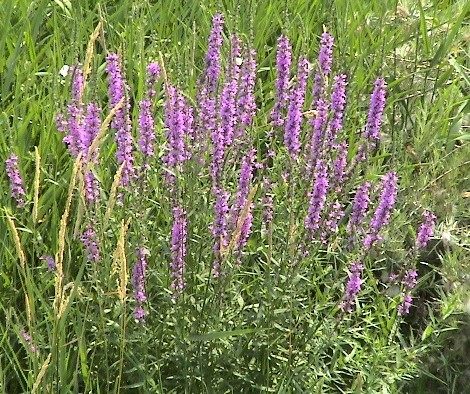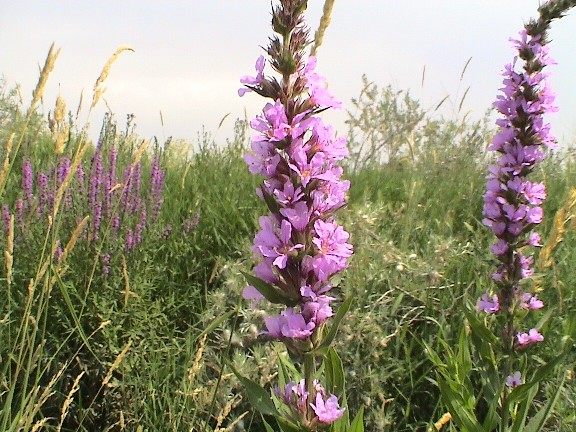Purple Loosestrife (Lythrum salicaria L.)
Identification
Purple loosestrife is a native forb of Europe. It is a taprooted perennial; short rhizomes also exist. This plant is considered a noxious weed and is included on the Colorado and the Adams County Noxious Weed Lists. Purple loosestrife has escaped from ornamental plantings to aquatic sites such as riverbanks, ditches, shorelines, and wet meadows. Infestations rapidly replace native vegetation, can impede water flow in canals and ditches, and have little wildlife habitat value.
 This noxious weed spreads primarily by seeds carried in water, in fur of feather of animals, and from human activities. One mature plant can produce up to 3 million seeds per year! Seeds survive in the soil for 5 to 20 years. Pieces of roots or stems also can produce new plants. Purple loosestrife produces multiple stems, 2 to 8 feet tall and 4-sided. They can either be smooth or hairy. Leaves are opposite or whorled on stems, 2 to 5 inches long, tongue-shaped with pointed tips and attached directly to the stem (no petiole). Flowers are reddish-purple in color and have 5 to 7 petals.
This noxious weed spreads primarily by seeds carried in water, in fur of feather of animals, and from human activities. One mature plant can produce up to 3 million seeds per year! Seeds survive in the soil for 5 to 20 years. Pieces of roots or stems also can produce new plants. Purple loosestrife produces multiple stems, 2 to 8 feet tall and 4-sided. They can either be smooth or hairy. Leaves are opposite or whorled on stems, 2 to 5 inches long, tongue-shaped with pointed tips and attached directly to the stem (no petiole). Flowers are reddish-purple in color and have 5 to 7 petals.
Cultural Management
Since Purple Loosestrife invades wet habitats, cultural management techniques are difficult to use. Vegetation should not be over grazed in or near riparian areas. Sites without vegetation should be reseeded to adaptable, competitive plants. However, purple loosestrife has the ability to continue to invade even heavily vegetated sites. This means that supplemental management methods are needed, in addition to cultural. One effective cultural technique is to eliminate loosestrife from ornamental plantings.
Mechanical management
For infestations of a few plants, purple loosestrife can be controlled, especially on sandy soils, by hand pulling or digging seedlings before they produce seed. More mature plants may require digging to be uprooted. Remove all stems and roots by putting them in bags to prevent them from sprouting new plants. Another mechanical method is to cut flower heads before they seed.
Biological Management
Two species of beetles (Galerucella calmariensis and Galerucella pucilla) are showing some promise for biological control of loosestrife. Releases of at least 500 beetles per infested site are needed. These beetles eat leaves, small stems, and flowers, and can completely defoliate loosestrife plants. Two other insects, a root weevil (Hylobiau transversovitatus) and seed weevil (Nanothyes spp.) are in early research stages.
Herbicide Management
For early season control of seedling and regrowth plants less than 1-2 feet tall, use aquatic-labeled 2,4-D is effective. Look for seedlings where adult plants have grown.
For Mature plants, the only labeled option is Rodeo at pre-flowering to post bloom stages. For spot spraying use a 1.0 to 1.5% solution plus .5% of nonionic surfactant. A wiper application can be used with a 33.3% solution of Rodeo, plus 5 to 10% surfactant, at the full-flower stage. Be extremely careful when applying Rodeo, it is a nonselective product that will kill all other vegetation that it comes in contact with. It is also recommended that all flowerheads are removed and bagged prior to herbicide application. This will reduce the amount of seed dispersal.
Always read and follow label instructions when making any application. Consult with your local pesticide dealer or extension agent for specific recommendations.
Integrated Management in Riparian Sites
Hand-pull or dig out small infestations. Apply a labeled herbicide to larger infestations to reduce their size for mechanical treatment. Apply 2,4-D to early growing plants to avoid killing desirable vegetation with use of Rodeo.




